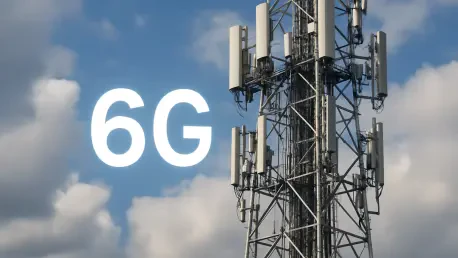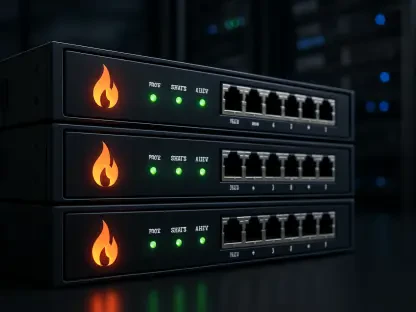Demand for instant decisions at planetary scale has pushed connectivity, computing, and sensing toward a single nervous system that fuses radios, servers, and algorithms into one responsive fabric capable of acting in microseconds where milliseconds once sufficed. This shift is not a marketing flourish; it is a structural transformation driven by real workloads: industrial robots that coordinate without jitter, digital twins that stay in lockstep with physical assets, vehicles that negotiate in dense traffic, and immersive experiences that render with life-like presence. The march from 3G to 4G to 5G proved that throughput alone does not unlock the next wave of value. What now stands out is orchestration—placing data and decisions exactly where they matter, all while keeping power, spectrum, and security in balance. That is the promise of 6G, a system that treats computation as a native function of the network and turns radio links into instruments for perception, positioning, and control. The stakes are clear: whoever masters this convergence will define the vocabulary of intelligent infrastructure for the next decade.
Defining 6G
Ambition and Scope
6G targets a genuinely different operating point: extreme capacity across diverse bands, end-to-end latencies trending toward microseconds for specific functions, and reliable service at massive scale without breaking energy budgets. It builds on 3GPP’s machinery, with technical requirements expected by 2026 and initial specifications anticipated in Release 21 by 2028, but the design center has shifted from peak headline speeds to system intelligence. Native fusion of communications, computing, and sensing reframes the radio as a gateway into a distributed compute substrate, where AI steers resources in real time. This vision spans terrestrial and non-terrestrial domains, with LEO satellites and high-altitude platforms woven into a continuum that minimizes handoff friction and coverage gaps. The aspiration is not universal Tbps for every device; rather, it is predictable performance where needed, with elasticity to absorb spikes, and instrumentation to understand the environment as it changes.
In practical terms, 6G extends beyond evolutionary gains in modulation or coding, though those advances matter. The core ambition is to make networks programmable down to the physical layer while exposing hooks for applications to request fidelity, latency, and security in terms the system can honor. That requires AI-native control loops, precise timing, and high-resolution sensing that can locate devices and map surroundings with centimeter-level accuracy. Higher frequencies, including sub-millimeter and THz bands, unlock wide contiguous channels that enable huge bursts and fine-grained sensing, yet they also impose harsh propagation constraints. The architectural answer leans on densification, adaptive beams, reconfigurable surfaces, and workload placement that keeps compute close to the edge. Performance is only meaningful if delivered sustainably, so energy efficiency is raised to a first-class objective measured across radios, transport, and compute pools.
How It Differs From 5G
The defining difference is design intent: 5G bolted on edge computing and URLLC features across releases; 6G embraces an edge-native stance from day one, assuming that distributed compute is part of the RAN’s nervous system. Radio and compute scheduling converge, making the link layer aware of the tasks it carries, not just their bytes. This is inseparable from a push into higher frequencies, where beamforming becomes mandatory and radios double as sensors. Joint communication-and-sensing shifts from a research add-on to a built-in capability, allowing networks to map spaces, detect motion, and support precise positioning while moving data. AI permeates every layer: traffic forecasting, beam steering, interference mitigation, anomaly detection, and closed-loop optimization. The aim is a network that adapts continuously, refusing one-size-fits-all configuration and delivering determinism only where demanded.
Equally important, 6G reframes performance expectations. Rather than chasing a single “speedometer” metric, service-level thinking dominates: reliability distributions, worst-case latencies, and compute placement become configurable, policy-driven attributes. Duplexing experiments continue, with researchers probing more seamless schemes and chipping away at self-interference barriers that have constrained full-duplex ambitions. Spectrum strategy widens as well: multilayer bands combine sub-7 GHz coverage, mid-band capacity, and high-band/THz bursts where line-of-sight and density permit. The outcome, if achieved, is a platform for real-time AI and control, not merely better streaming. That platform rests on open, composable components so hardware refresh cycles and software evolution can advance independently, reducing lock-in and accelerating iteration.
Timeline and Standardization
3GPP and ITU Milestones
The standardization arc continues to firm up. 3GPP’s plan points to 6G technical performance requirements around 2026, with the first tranche of specifications in Release 21 by 2028. Meanwhile, Release 20, launched in early 2025, advances 5G‑Advanced while incubating early 6G concepts in parallel tracks, allowing the industry to field-test building blocks like extreme MIMO, sidelink evolution, and joint sensing before codifying them fully. The ITU’s IMT‑2030 framework, finalized in 2023, set out capability ranges spanning peak throughput, spectrum efficiency, coverage, energy use, and trustworthiness, giving national regulators and regional programs a shared vocabulary for objectives and test scenarios. These markers do not guarantee market timelines, but they anchor investment and interoperability bets.
The process also hinges on regulatory alignment. In the United States, experimental authority above 95 GHz opened the door for THz research, component prototyping, and channel modeling at scale, while other regions ramped their own testbeds to validate antenna designs and wave propagation under real weather and urban clutter. Convergence on channel bandwidths and carrier placements remains sensitive, especially around candidates like 7 GHz for 200 MHz channels, where incumbents and defense uses complicate reallocation. Nevertheless, the cadence has held: requirements first, radios and chipsets maturing alongside, and harmonization culminating in profiles implementable by vendors without exotic manufacturing. In parallel, assurance frameworks evolve to include AI behavior, not just protocol compliance, reflecting a view that network “correctness” now includes model integrity and predictable adaptation.
Commercialization Outlook and Bridging Via 5G‑Advanced
Commercialization signals have clustered around the early 2030s, with some vendors flagging pilots as soon as 2028 and broader availability near 2030. The ecosystem, however, needs a bridge, and 5G‑Advanced serves that role by mainstreaming features that 6G will treat as native. Operators are already trialing integrated sensing, time-sensitive networking extensions, and massive MIMO expansions, using Release 20 as a proving ground for control-plane and RAN automation. These efforts are not cosmetic. They seed operational muscle memory: how to place inference at cell sites, how to synchronize tight loops across edge zones, how to monitor and govern AI in closed-loop control. Lessons learned feed directly into 6G architecture choices, reducing risk and shortening later trial phases.
Bridging also softens capital intensity. Densification, fiberized fronthaul, and edge compute require credible revenue paths, so pilots are paired with enterprise use cases—robotics, inspection, teleoperation, and advanced XR—where deterministic service and sensing can command premiums. Device ecosystems lag by design; practical THz-capable handsets will depend on RF front ends, antennas, and materials becoming efficient and affordable. That makes early commercialization more likely in fixed or semi-fixed scenarios—industrial campuses, venues, and hotspots—where hardware constraints and line-of-sight can be engineered. As policy aligns on spectrum, and as multivendor interoperability hardens around Release 21 profiles, the broader consumer market follows. Research on “beyond 6G” is underway, but it remains exploratory, offering a north star rather than a near-term roadmap.
Radio, Spectrum, and Architecture
High Bands and THz Paths
The allure of THz bands lies in wide contiguous channels that unlock extreme peak rates and fine-grained sensing, but physics is unforgiving. Free-space path loss rises sharply with frequency, and atmospheric absorption lines carve notches that vary with humidity and distance. To make these bands useful, 6G designs rely on narrow, high-gain beams steered by large antenna arrays, hybrid beamforming to manage RF chain counts, and metamaterials or reconfigurable surfaces to redirect energy around obstacles. New RF front ends must handle wide bandwidths while staying linear and efficient, and local oscillators must remain stable under rapid beam updates. Silicon germanium and compound semiconductors are both in play, with packaging and thermal strategies determining whether designs can scale beyond labs.
Operating above 52.6 GHz also changes measurement and maintenance. Calibration across bands, beam patterns, and temperature excursions cannot be an afterthought, so test and measurement methodologies evolve alongside radios. The reward is not just headline bursts; it is the ability to sample the environment with high spatial and temporal resolution, enabling joint communication and sensing without separate sensors. However, system designers temper ambition with hybrid spectrum strategies, leveraging sub-7 GHz for coverage anchors, mid-bands for broad capacity, and high/THz layers for on-demand peak performance. This multilayer approach reduces brittleness, lets mobility stay fluid across obstacles, and supports graceful degradation when weather or crowd density shifts channel conditions.
Coverage, Mesh, and NTN Integration
Because high bands struggle with blockage, coverage relies on density and topology more than raw power. Small cells and repeaters, placed with awareness of street canyons and indoor layouts, create a fabric of line-of-sight islands stitched together by beam tracking and smart handoffs. Mesh-like principles add resilience: devices and intermediary nodes can relay or assist when direct paths fail, while reconfigurable intelligent surfaces reflect or refract beams to “bend” around corners. This stitches high-band capacity into practical coverage maps without overbuilding. Crucially, non-terrestrial networks expand the fabric vertically. LEO satellites and HAPS fill rural and maritime gaps, provide continuity for moving platforms, and serve as backhaul where fiber is impractical, with latency far below geostationary links and capacity shaped by spot beams.
Integration is not a bolt-on. Control-plane unification ensures mobility and session continuity as users drift across terrestrial cells and satellite footprints, while policy engines decide when to offload to NTN based on SLAs, energy, and link budgets. Antennas and modems become multimode, with agile spectrum sensing to avoid interference in shared bands. For enterprises, private networks may blend local small cells with satellite overlays for resilience, especially in critical infrastructure and logistics. The challenge is to avoid fragmentation: open interfaces and harmonized profiles must allow vendors to innovate without breaking interoperability. As NTNs standardize and payloads grow more flexible through software-defined radios in orbit, this terrestrial–non-terrestrial symbiosis shifts from niche to mainstream.
Spectral Efficiency and Duplexing Advances
With spectrum scarce and expensive, 6G doubles down on efficiency. Evolved waveforms and coding target higher robustness at the edges of coverage and in dense interference, while massive MIMO moves beyond simple beam steering into multi-user precoding that packs more simultaneous streams into the same hertz. AI aids channel estimation and prediction, adapting to mobility patterns and reflections that elude static models. Interference becomes a managed resource: coordinated multipoint and dynamic TDD align transmissions across clusters to prevent self-inflicted collisions. Researchers continue to probe more seamless duplexing, chasing the dream of true same-frequency transmit and receive without crippling self-interference. Progress is real—cancellation techniques have improved—but practical constraints remain, especially for power-limited devices.
Even without pure full-duplex, gains are available through smarter scheduling and partial duplex modes that shrink guard times and better exploit asymmetry in uplink and downlink demand. The emphasis is on end-to-end yield: radios, MAC, and schedulers cooperate with the compute layer to place tasks where channel conditions are favorable, rather than brute-forcing bits through weak links. This mindset values predictability as much as peaks, especially for control loops and industrial traffic where jitter kills utility. As Release 21 firms up profiles, vendors will likely offer selectable modes tuned for sensing-heavy, uplink-heavy, or bursty downlink scenarios, letting operators tailor cells by venue and workload rather than chasing a universal configuration that satisfies none perfectly.
Compute-Native Networks and AI
Edge-Native Orchestration
In 6G, compute is not a peripheral add-on; it is a first-class resource orchestrated with spectrum and power. Workloads—network functions, AI inference, graphics rendering, sensor fusion—float across device, edge, and core according to policy and real-time conditions. Orchestrators understand latency budgets, reliability targets, energy constraints, and cost, then place tasks accordingly while keeping state consistent. This demands fine-grained telemetry and control: time synchronization to the microsecond, hardware acceleration awareness, and health signals that let the platform predict failures before they manifest. Data paths must be equally fluid, with programmable transport and in-network computing reducing backhaul load by aggregating, filtering, and compressing at the edges.
Such choreography does not succeed without a common abstraction. The “nano-core” concept helps: a logical pool of compute across domains that exposes consistent APIs for deployment, scaling, and security. It treats accelerators as fungible resources, whether on a baseband card, at a street-corner micro data center, or in a regional facility. Applications ask for outcomes and guardrails, not machines, and the platform translates those needs into placements and reservations. When channel conditions shift or a beam drops, the system migrates microservices or spin-ups replicas close to the new best path. This dynamic placement blurs the old boundary between “network” and “application,” creating a coordinated fabric that aims to meet SLAs with the least energy and cost.
AI-Driven Control and Automation
The complexity of a dense, multi-band, multi-domain network resists manual control. AI becomes the control plane’s co-pilot, forecasting traffic, tuning beams, scheduling resources, and detecting anomalies faster than human operators can react. Models operate at different cadences: fast loops steer beam patterns and retransmissions; mid loops plan resource blocks and power; slow loops optimize topology, maintenance, and upgrades. Crucially, AI must be governable. Operators need explainability for change windows and postmortems, and they need guardrails that prevent cascading effects from a misbehaving model. Policy engines define limits, and change management incorporates simulation and staged rollout, with canary cells testing new behaviors before wide deployment.
At the service layer, AI automates placement of inference, caching, and state replication for applications. It learns which zones experience XR rushes, which factory lines create sporadic uplink spikes, and where satellite handovers are predictable, then prepositions compute or capacity. This orchestration turns cost knobs as well as performance knobs, throttling energy use during low demand and collapsing idle clusters into deep sleep. Security also benefits: models watch for aberrant signaling or traffic that suggests compromise, while federated learning lets models improve from broad experience without leaking sensitive data. In the aggregate, AI does not replace human oversight; it amplifies it, shrinking reaction windows and freeing experts to focus on policy and design rather than firefighting.
Security-By-Design Foundations
Convergence raises stakes for security. Hardware roots of trust anchor identity in radios, servers, and devices, while attestation ensures that code—firmware, baseband, container—has not been tampered with. Zero trust design treats every lateral hop as untrusted, enforcing segmentation by default and requiring continuous verification for access. Strong cryptography protects data in motion and at rest, and post-quantum transitions are planned with dual-stack periods to avoid cliff-edge cutovers. Supply-chain integrity becomes a constant practice, with signed artifacts, reproducible builds, and software bills of materials enabling audits and rapid remediation during advisories.
AI itself must be secured. Models can drift or be poisoned; their outputs can be manipulated by crafted inputs that look benign to humans. 6G hardens the AI pipeline with robust training data governance, differential privacy where needed, and monitoring that spots distribution shifts and flags when confidence drops. Assurance expands beyond conventional conformance testing to include behavior under stress: does the system degrade safely when sensing is noisy, when timing skews, or when partial outages occur? Security is not an overlay; it is embedded in orchestrators, RAN control, and service meshes. The aim is resilience: even under attack or failure, the network should maintain critical functions and recover gracefully without human heroics.
Integrated Sensing and Positioning
Joint Communication and Sensing
At high frequencies, radio signals become rich sources of environmental information. 6G leverages this by making joint communication and sensing a foundational capability: the same waveforms that deliver bits also probe spaces, revealing positions, motion, and material signatures with fine-grained precision. This allows networks to support centimeter-level positioning indoors and outdoors, enhance situational awareness in public safety, and enable industrial applications like collision avoidance and robot coordination without additional sensors. Waveform design, radar-like processing, and MIMO exploitation underpin these functions, while careful scheduling prevents sensing functions from starving communications and vice versa.
Turning the RAN into a “sense-and-serve” platform changes how applications interact with the network. An app can request a position update cadence, a field-of-view, or an occupancy map rather than raw throughput, and the platform translates those asks into beam patterns and processing tasks. Privacy and policy are critical, so data is abstracted or processed locally whenever possible, exposing only the necessary insights instead of raw feeds. Accuracy also becomes an SLA attribute, with bounds and confidence intervals surfaced alongside location estimates. In environments with strong reflections or crowds, multi-static sensing—combining observations from several nodes—improves robustness, and fused signals from NTN overlays help maintain continuity in open areas where terrestrial density dips.
Data Management and Privacy For Sensing
Sensing floods systems with data, and careless handling risks both overload and privacy breaches. 6G addresses this by pushing compute to the edge for early filtering, aggregation, and anonymization. Only essential features traverse the network, shaped by policies that enforce retention windows and minimize exposure of personally identifiable information. Federated learning lets models improve across sites without centralizing raw data, while secure enclaves run sensitive analytics on encrypted inputs where regulations demand. Metadata governance becomes a discipline of its own: provenance, consent, and purpose tags travel with datasets so automation respects legal and contractual boundaries.
Monetization depends on trust. Enterprises and public agencies will only consume sensing-as-a-service if they have assurances about data handling and redress in case of misuse. Standardized audits, transparency reports, and third-party certifications help, as do clear mechanisms for revocation and emergency halt. From a performance standpoint, data pipelines must be predictable; buffering and prioritization match the cadence of control loops, and loss-tolerant encodings ensure graceful degradation under congestion. The goal is a system that treats sensing as a durable, governed capability—not a side channel—unlocking use cases from smart buildings and retail analytics to precision agriculture and infrastructure inspection without eroding civil liberties.
Use Cases and Application Domains
Evolved 5G Scenarios at New Scale
6G pushes familiar 5G scenarios into regimes that were hard to reach consistently. Autonomous systems gain tighter control loops as round-trip times shrink and reliability tails improve, allowing fleets of robots to coordinate without conservative buffers that slow productivity. In industrial automation, deterministic performance supports closed-loop control and quality inspection with AI at the line, while edge-native rendering brings XR work instructions to technicians without nausea-inducing jitter. Remote operations benefit from predictable uplink for video and sensor feeds, plus dynamic placement of inference for haptics and teleoperation. The difference is not a shiny demo; it is consistency under pressure, across shifts, and during partial outages.
Media experiences also evolve. Higher bandwidth and smarter scheduling allow multiple concurrent high-fidelity streams—video, spatial audio, haptic cues—without stepping on each other, while joint sensing improves positional accuracy for AR overlays. Education, training, and design workflows, often crippled by motion-to-photon delays, become tolerable for longer sessions and more users per cell. Importantly, these improvements ride on policy-driven orchestration that aligns compute, radio, and energy with task priorities. Operators can sell deterministic slices with measurable guarantees, and enterprises can engineer end-to-end processes that rely on the network as a partner, not a best-effort pipe.
New Capabilities Unlocked
Integrated sensing opens categories that were not practical with prior generations. Public safety can gain situational awareness through presence detection and imaging without invasive cameras, while precise positioning supports search-and-rescue and evacuation coordination in complex structures. In healthcare, high-resolution biosensing—subject to strict privacy—enables monitoring in hospitals and at home, with edge inference flagging anomalies for fast intervention. Environmental sensing extends to air quality, gas detection, and structural health, creating living maps that guide maintenance and policy. Security contexts, such as access control and perimeter defense, benefit from multifactor signals that reduce reliance on brittle facial recognition alone.
Sensory interfaces also become richer. Haptics synchronized over low-latency links translate network data into touch, supporting remote manipulation, training, and entertainment. These functions push demanding uplink patterns and require fine-grained jitter control, showcasing 6G’s edge-native compute and scheduling. The key is orchestration and governance; capability without policy breeds misuse. By embedding identity, consent, and audit into sensing workflows, 6G supports these advances responsibly, giving operators and enterprises tools to balance innovation with safeguards and to align usage with community norms and legal frameworks.
Digital Twins and Immersive Experiences
End-to-end digital twins depend on timely, accurate data and the ability to simulate and act without lag. 6G’s compute-aware fabric brings training and inference close to sensors, while high-rate, low-jitter links keep virtual models synchronized with physical systems. Factories mirror production cells; grids shadow load and generation patterns; cities visualize traffic, air, and water flows with enough fidelity to adjust in near real time. This is not a static dashboard; it is a feedback instrument, with AI-driven recommendations applied through automation when thresholds cross. Deterministic latency allows control actions to close loops safely, while energy-aware placement ensures that the cost of fidelity does not outstrip its benefit.
Immersive AR/VR and mixed reality become everyday tools rather than event novelties. Rendered at the edge, scenes adapt to eye and head movement instantly, enabling design collaboration, training drills, and telepresence with a sense of embodiment that videoconferencing cannot match. Higher bandwidth helps, but orchestration matters more: predictive rendering at the edge, synchronized with device sensors, reduces motion sickness and allows wearable devices to stay light and power-frugal. For venues and campuses, private slices guarantee experience quality, while public networks scale the same capabilities citywide. As device ecosystems mature, these experiences expand beyond headsets to include holographic displays and tactile feedback, knitting physical and digital presence into a seamless whole.
Global Programs and Industry Posture
Research Consortia and National Pushes
Global coordination has accelerated. Europe’s Hexa‑X and Hexa‑X‑II programs knit together operators, vendors, and academia to chart end-to-end blueprints that stress openness, modularity, and trustworthiness, while Finland’s 6G Flagship shapes radio and architecture concepts alongside cross-regional partnerships. In Asia, Korea’s ETRI advances THz research and system design with government backing, and China’s THz-equipped test satellites validate non-terrestrial integration and high-frequency payloads in orbit. North America’s Next G Alliance gathers carriers and tech companies to prioritize research and influence standards, buttressed by spectrum experiments above 95 GHz that legitimize component and channel studies beyond paper models.
These programs matter because 6G’s scope crosses traditional silos. Radio, compute, sensing, and policy must align for the platform to function as envisioned. Multigovernment statements have signaled priorities—openness, interoperability, security by design—and governmental bodies have synchronized spectrum and standards participation to avoid regional drift. Collaboration does not mean uniformity; regional needs and industrial bases differ. Yet shared frameworks like IMT‑2030 and cross-consortia dialogues prevent fragmentation that would cripple economies of scale. The healthiest sign is the breadth of participation: chipmakers, cloud providers, telecoms, and research labs co-own the agenda, acknowledging that the next generation is a system, not a stack of parts.
Vendor Viewpoints and Recent Milestones
Vendors have sketched timelines and targets with cautious optimism. Samsung outlined an “earliest commercialization” around 2028 and broad adoption near 2030, coupled with sub‑100 µs air latency aspirations and MIMO evolution that pushes antenna counts and metamaterial designs. Trials underscore feasibility: LG demonstrated a 100‑meter outdoor 6G link with adaptive beamforming; a reported small “full‑spectrum 6G” chip achieved 100 Gbps in lab conditions; university teams explored THz multiplexing on silicon to hit double‑digit Gbps in specific setups. These are not production metrics, but they anchor engineering discussions and shape investment in front ends, oscillators, and packaging techniques.
The posture across infrastructure suppliers is consistent: continued heavy R&D in RAN, core, and device technologies, with test and measurement firms refining methods to characterize THz behavior and protocol conformance at scale. Operators, wary of capex spikes, pair trials with enterprise pilots that can justify densification and edge nodes. Device makers prototype antennas and materials that balance performance with thermal limits and battery life, knowing that consumer adoption hinges on comfort and longevity as much as bandwidth. Through it all, a sober note prevails: terabit bursts in pristine lab lines of sight will not define user experience. What counts is predictable service where business and safety require it, and graceful fallback when conditions degrade.
System Evolution and Operations
From RAN to Nano-Core and Edge-Core Symbiosis
The network evolves from a radio access layer plus a distant core into a “nano-core”—a logical, pooled compute core that spans edge and regional facilities and allocates resources with fine granularity. In this model, data centers host network functions alongside AI inference and training, with strict SLAs and precise timing across domains. The packet core, once monolithic, becomes a set of microservices scheduled like any other workload, optimized for placement near demand spikes. Service meshes enforce identity and policy across clusters, and telemetry feeds a control loop that treats compute, storage, and transport as co-equal dimensions to tune.
This symbiosis reshapes operations. Maintenance windows become rolling, with live migrations and blue-green deployments standard even for RAN components. Observability moves down to the RF chain and up to the application—spans track how a haptic command traveled, where it was processed, and how long each stage took. The payoff is agility: new features, codecs, and ML models can roll out without forklift upgrades and can be customized per venue or enterprise. The risk is complexity, so automation, intent-based configuration, and strong guardrails are mandatory to prevent configuration drift and cascading failures. When done right, the nano-core model converts static infrastructure into a programmable utility.
Energy Efficiency and Sustainability
Energy has shifted from cost line to design constraint. Higher bands and dense deployments could drive power up unless countered with smarter hardware and orchestration. 6G treats energy as a KPI at parity with throughput and latency. Radios enter deep sleep aggressively, woken by low-power side channels; beamforming minimizes spillover; and AI forecasts traffic to preheat or hibernate clusters just in time. Materials and device design matter too: efficient PAs, low-loss interconnects, and thermal paths reduce waste, while photonic links in data centers cut switching losses for fronthaul and backhaul at scale. Metrics become richer than watts per bit—they include joules per task or per SLA, reflecting compute alongside transport.
Sustainability also extends to lifecycle and sourcing. Modular designs prolong hardware usefulness; open interfaces let older components serve in lower tiers instead of scrapping. Renewable energy integration improves, with orchestrators aligning workload peaks with generation where possible. Reporting aligns with regulatory schemes that require transparency on energy use and emissions. Efficiency is not merely altruistic; it is a hedge against operating costs and grid constraints as densification progresses. As operators learn which levers yield meaningful savings without harming experience, those practices become standard, and energy-aware scheduling becomes as normal as congestion control.
Toughest Challenges
Physics, Deployment, and Energy Realities
The physics of THz propagation impose non-negotiable constraints. Blockage, atmospheric absorption, and line-of-sight requirements mean dense site grids, meticulous placement, and robust beam management. That raises deployment complexity and cost, particularly in urban and suburban areas where site access, permitting, and aesthetics can delay rollouts. Backhaul and fronthaul must scale in lockstep, often requiring fiber or high-capacity wireless relays that are themselves sensitive to alignment and weather. Power availability at small-cell sites becomes a gating factor, especially when layering compute for edge inference. These realities argue for hybrid spectrum strategies and target-first deployments where revenue and impact justify investment.
Engineering ingenuity can mitigate but not erase constraints. Reconfigurable intelligent surfaces help redirect beams; multi-connectivity eases path loss shocks; and predictive control reduces drops during mobility. Yet each mitigation adds components and operational complexity that must be justified by measurable benefits. Energy remains a persistent challenge, as radios and compute at the edge raise aggregate consumption unless dormancy, consolidation, and efficient silicon deliver countervailing gains. The operational art lies in using automation to keep the system within efficient envelopes while honoring SLAs, with graceful degradation plans that keep critical services alive under stress.
Spectrum, Cost, and Ecosystem Maturity
Spectrum is a shared, political resource. Bands attractive for wide channels may already host defense or scientific services, and reallocation or sharing requires careful engineering and international coordination. Harmonization affects device economics; globally fragmented band plans drive complexity and cost in RF front ends and antennas. Meanwhile, capital expenditures for densification, fiberized transport, and edge compute are substantial. Operators need credible business cases—industrial automation, sensing-as-a-service, premium deterministic slices—to justify the spend. Without them, rollouts risk stalling in pilot purgatory.
Ecosystem maturity is the final gate. Handsets, modules, and IoT devices must integrate practical, power-efficient components at scale; test equipment must validate performance and conformance; and supply chains must deliver predictable volumes. Standards must converge enough to enable multivendor interoperability without stifling innovation. Security and assurance add their own overhead, as buyers demand verifiable claims about resilience and privacy. The path forward depends on coordinated progress: standards setting realistic profiles, regulators providing clear spectrum trajectories, vendors delivering viable silicon and software, and customers signaling demand through pilot-to-production pipelines that reward performance with revenue.
Policy and Collaboration
International Frameworks and Regional Strategies
Policy is not an afterthought; it sets the boundary conditions for innovation. The IMT‑2030 framework provides common objectives and scenario definitions, anchoring debates on capabilities, coverage, and sustainability. Multigovernment statements have emphasized openness, interoperability, and resilience, shaping expectations for how 6G should be built and governed. In the United States, NTIA and FCC moves on spectrum exploration above 95 GHz catalyzed research, while European programs prioritized openness-first architecture blueprints that ease multivendor integration. Asian investments, notably in THz research and satellite testbeds, highlight a pragmatic mix of terrestrial and non-terrestrial focus to meet national goals.
Regional strategies also reflect different industrial bases. Europe leans into open interfaces and supply-chain diversity; North America blends telecom and cloud assets; Asia advances component and system integration at scale. These differences are strengths if harmonized through interoperable profiles and roaming agreements. Security baselines must rise globally, with shared testing regimes for AI behavior, software supply chains, and hardware trust anchors. Data governance will vary by jurisdiction, but common mechanisms for consent, audit, and redress ease cross-border services. The most effective policy moves have balanced ambition with realism, creating room for experimentation without locking the industry into dead-end choices.
Security, Trust, and Governance at Scale
As sensing proliferated and compute moved to the edge, governance had to match the system’s reach. Identity and segmentation prevented lateral spread when incidents occurred, while continuous monitoring spotted deviations before they snowballed. Privacy safeguards, including differential privacy and federated learning, reduced exposure without starving models of learning signals. Standardized assurance for AI and software supply chains gave buyers confidence that automation behaved within guardrails and that updates could be rolled out swiftly under scrutiny. These practices turned “secure by design” from a slogan into a measurable posture that enterprises and agencies could audit and trust.
The most actionable next steps centered on codifying these controls into procurement and operations so that pilots translated into durable deployments. Operators prioritized attestation frameworks, energy-aware SLAs, and sensing data governance as baseline features, not add-ons. Vendors focused on verifiable AI modules, open interfaces for orchestration, and efficient RF front ends that lowered power without sacrificing performance. Regulators aligned spectrum plans with realistic device timelines and funded cross-industry testbeds to validate interoperability and resilience. Taken together, the posture set the stage for 6G to scale responsibly: ambitious in capability, grounded in physics and economics, and deliberate in how intelligence, sensing, and connectivity intertwined to serve both industry goals and public trust.









